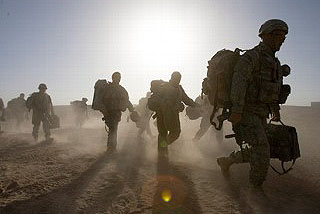Every week I write a short blog post that goes into a weekly newsletter that MoJo sends out via email each Friday. I’ve never reposted them here because I write these things on Wednesday night, and by Saturday they already feel ancient. But that’s a little silly, no? So I think I’ll start putting them up on the blog on Saturday morning so that people can comment on them if they want. Here’s yesterday’s edition.
Last week I was talking to a friend whose son is currently stationed in Afghanistan. He was pretty scathing about how the war is being prosecuted. We’re supposed to be engaged in a counterinsurgency campaign there, he told me, which means getting  soldiers out from their camps and into the towns and cities. They should be patrolling continuously, making their presence felt, and engaging with local leaders. But his son reported that none of that was happening.
soldiers out from their camps and into the towns and cities. They should be patrolling continuously, making their presence felt, and engaging with local leaders. But his son reported that none of that was happening.
That’s only one unit, of course, and enlisted men are rarely privy to the bigger picture. Maybe there’s a reason this particular unit is twiddling its thumbs for the moment. Unfortunately, there’s reason to suspect that the problem runs deeper and wider than that. And even more disturbingly, there’s pretty good reason to think that even if the Army steps up its game, it won’t do any good. Gen. Stanley McChrystal is currently planning a make-or-break offensive in the Taliban stronghold of Kandahar, but a source there who’s a firm believer in counterinsurgency doctrine has recently become profoundly disillusioned. In “A Counterproductive Counterinsurgency,” a memo currently wending its way through official channels in Afghanistan, he says:
The idea of “counterinsurgency” appears to be a viable way for success on paper. Military units, along with NGO’s [non-governmental organizations], the Department of State, GIRoA [the Afghanistan government], and other government agencies work together to emplace the clear, hold, build strategy in key areas of the battlefield. Like communism, however, counterinsurgency methods are not proving to be effective in practice.
The history of foreign powers mounting successful counterinsurgencies is bleak. Too little force and you can’t protect the local population. Too much force and you risk enough civilian damage to push them into the hands of the insurgents. It is, in T.E. Lawrence’s famous phrase, like eating soup with a knife, and most practitioners can point to only one significant success in the modern era: the Malayan Emergency of the late 40s and 50s. Plus, of course, Gen. David Petraeus’s famous victory in Iraq in 2007. But even that should give pause for thought. For starters, it’s not clear yet that counterinsurgency has actually worked in Iraq: the government is less stable now than ever and violence is again on the rise. Beyond that, though, the success in Iraq was due not just to Petraeus’s surge, but to what I call the Four Esses. The Surge was one of them, but it wouldn’t have worked without the other three: the Sunni Awakening that turned tribal leaders against al-Qaeda in Iraq; the sectarian cleansing that displaced millions of Iraqis and purged mixed neighborhoods in Baghdad; and Muqtada al-Sadr, who declared a cease fire long before Petraeus arrived and, against all odds, stuck to it.
None of those things is present in Afghanistan, and so far the evidence suggests that without them we have little chance of replicating even the contingent success we had in Iraq. This is something that the Pentagon seems to be belatedly recognizing as it tries to downsize future operations. Counterinsurgency, says Andrew Exum, a fellow with the Center for a New American Security, “is a good way to get out of a situation gone bad,” but it’s not the best way to use combat forces. Afghanistan, unfortunately, is starting to look like the graveyard of empires once again.

















